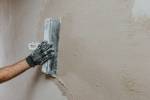Adding wall coverings can spruce up your home
Wallpaper can be an efficient and effective way to spruce up a house without taking up any room. Wall coverings have been around for hundreds of years, but admiration waxes and wanes with each decade.
It seems that consistent popularity depends on regional housing styles. In the more traditional East, South and Midwest, classic homes have been more conducive to the application of paper than contemporary or Santa Fe-style homes. Other types of wall treatments have gained a foothold out West; treatments such as Venetian plaster, faux and decorative finishes. I have witnessed these phases with curiosity.
Back in the 1970s when I started my design career, Mylar patterns were hot. These included shiny geometric patterns that were printed in silver, gold and copper metallic paint. Papers were bold and intended to deliver a big punch. Often just one wall received these strong designs — that was all that a room could stand.
We used papers like this in commercial situations and also in homes. It was also an era when photographic murals were considered the rage and replaced the paper landscape murals of the 1930s or 1940s.
As far back as colonial days, fine homes featured traditional scenic wallpaper in a stairwell, foyer or dining room. These might depict a Chinese scene with people, landscape and animals or a classic French toile pattern.
Today, you can still find examples in historic colonial homes up and down the East Coast and into the South. England and France were the main producers of enormous panorama papers toward the end of the 18th century.
Britain eventually emerged as the king of wallpaper production, and multiple patterns are still popular in contemporary English design. Pattern on pattern especially is used in a way not often seen in the U.S. market.
As wallpaper is printed with current color schemes, the material might become dated more quickly. Wallpaper books stay in print for several years at a time, but you could find it difficult to replace a paper originally printed 25 years ago. It may become necessary to change your entire color scheme or select a neutral pattern instead if you don’t want to change upholstery.
Nevertheless, after weighing the enormous impact of a wall or two decorated with a dynamic wallpaper pattern against the blandness of a simple coat of paint, one easily can be convinced of the value. Good places for accent wallpaper are powder bathrooms, foyers, staircase walls, dining room walls and bedrooms.
In this vibrant example of use, a key wall in the home is adorned with a pattern. Consider how the entire color scheme of adjacent rooms might be pulled from the floral paper hung on an entry wall. In the pattern you will find colors for drapery fabric, upholstery colors and art accents.
Often a pattern is available in several ways. There is typically a story or a series of companion-like patterns that go together.
In general, reserve larger pattern repeats for larger areas and use the undersized pattern repeats in smaller rooms. Additionally, a pattern might be printed on different backgrounds. If you seek out a design that is printed on white or off-white, it can be easier to blend into an existing color scheme.
Know, however, that you need a skilled installer when you hang paper with a white background. The seams show more when the background is pure white. Patterns printed on tan or a colored ground are more forgiving.




























